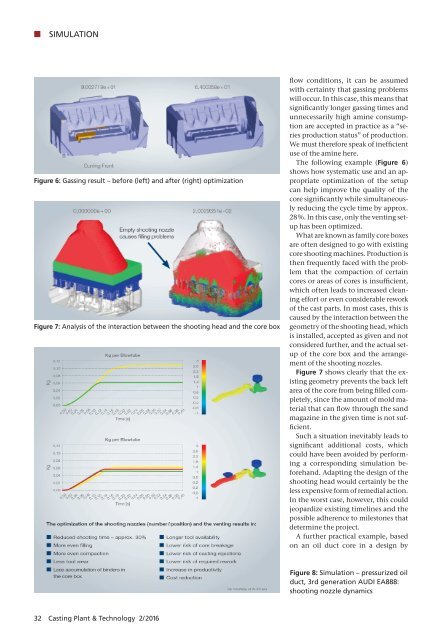CPT International 02/2016
The leading technical journal for the global foundry industry – Das führende Fachmagazin für die weltweite Gießerei-Industrie
The leading technical journal for the
global foundry industry – Das führende Fachmagazin für die
weltweite Gießerei-Industrie
Create successful ePaper yourself
Turn your PDF publications into a flip-book with our unique Google optimized e-Paper software.
K SIMULATION<br />
Figure 6: Gassing result – before (left) and after (right) optimization<br />
Figure 7: Analysis of the interaction between the shooting head and the core box<br />
flow conditions, it can be assumed<br />
with certainty that gassing problems<br />
will occur. In this case, this means that<br />
significantly longer gassing times and<br />
unnecessarily high amine consumption<br />
are accepted in practice as a “series<br />
production status” of production.<br />
We must therefore speak of inefficient<br />
use of the amine here.<br />
The following example (Figure 6)<br />
shows how systematic use and an appropriate<br />
optimization of the setup<br />
can help improve the quality of the<br />
core significantly while simultaneously<br />
reducing the cycle time by approx.<br />
28 %. In this case, only the venting setup<br />
has been optimized.<br />
What are known as family core boxes<br />
are often designed to go with existing<br />
core shooting machines. Production is<br />
then frequently faced with the problem<br />
that the compaction of certain<br />
cores or areas of cores is insufficient,<br />
which often leads to increased cleaning<br />
effort or even considerable rework<br />
of the cast parts. In most cases, this is<br />
caused by the interaction between the<br />
geometry of the shooting head, which<br />
is installed, accepted as given and not<br />
considered further, and the actual setup<br />
of the core box and the arrangement<br />
of the shooting nozzles.<br />
Figure 7 shows clearly that the existing<br />
geometry prevents the back left<br />
area of the core from being filled completely,<br />
since the amount of mold material<br />
that can flow through the sand<br />
magazine in the given time is not sufficient.<br />
Such a situation inevitably leads to<br />
significant additional costs, which<br />
could have been avoided by performing<br />
a corresponding simulation beforehand.<br />
Adapting the design of the<br />
shooting head would certainly be the<br />
less expensive form of remedial action.<br />
In the worst case, however, this could<br />
jeopardize existing timelines and the<br />
possible adherence to milestones that<br />
determine the project.<br />
A further practical example, based<br />
on an oil duct core in a design by<br />
Figure 8: Simulation – pressurized oil<br />
duct, 3rd generation AUDI EA888:<br />
shooting nozzle dynamics<br />
32 Casting Plant & Technology 2/<strong>2016</strong>


















